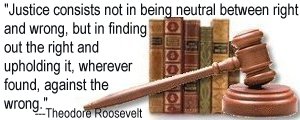« Condi Looses Mind In Brazil | Main | Thank You Senator Douglas ~ May Hanoi Jane Rot In Hell! »
March 15, 2006
It’s Legal


.
Wild Thing's comment...........
This is excellent! Long article but well worth it.
.
National Review Online
Bryon York
EDITOR’S NOTE: On Monday, when Wisconsin Democratic Sen. Russ Feingold introduced a resolution to censure President Bush, he said, "When the President of the United States breaks the law, he must be held accountable." Bush, Feingold continued, "authorized an illegal program to spy on American citizens on American soil and then misled the Congress and the public about the existence and the legality of that program." Although few Democrats have joined Feingold's call for censure, nearly all of them agree with Feingold's contention that the surveillance program is illegal. But the president's adversaries overlook the solid legal basis for the administration's actions.
The solid legal basis for the administration’s surveillance program.
In early September 2002, just before the first anniversary of the September 11 terrorist attacks, a group of lawyers gathered in a heavily protected, windowless room in the Department of Justice building in Washington. There were three federal appeals-court judges, Laurence Silberman, Edward Leavy, and Ralph Guy. There was Theodore Olson, the U.S. solicitor general. There was Larry Thompson, the deputy attorney general. And there was John Yoo, the Justice official who had closely studied questions of war powers and presidential authority. Rounding out the group were a few other department staffers, one official from the FBI, and David Addington, Vice President Cheney's top lawyer.
The purpose of the meeting was to argue a case whose details remain so classified that they are known by only a few people, but whose outcome, a decision known as In re: Sealed Case, has become one of the key documents in the hottest argument in Washington today: the fight over what President Bush calls the "terrorist surveillance" of persons with known al-Qaeda connections, and what the president's opponents call "domestic spying."
The three judges made up what is known as the FISA Court of Review. It was created in 1978 by the now-famous Foreign Intelligence Surveillance Act. The act required that the president go to the so-called FISA Court to seek a warrant for surveillance in top-secret foreign-intelligence cases. For any disputed decisions that might arise, Congress also created the Court of Review, a sort of super-secret appeals court.
But in all the years between 1978 and 2002, there had never been occasion for the Court of Review to actually meet. Not until Sealed Case, and the three-way collision between the executive, legislative, and judicial branches that it involved. Today, a look at the circumstances of the case provides not only an insight into the administration's rationale for the secret, warrantless surveillance program but also important clues to the mystery of how the whole thing got started in the first place.
The conflict began with the passage of the Patriot Act in October 2001. The act tore down the "wall" that had arisen in the Justice Department that blocked intelligence officials and criminal investigators from working together and sharing information. That wall had been cemented by a set of internal department guidelines written in 1995, in which then–attorney general Janet Reno outlined the department's constricted surveillance procedures.
The Patriot Act was designed to fix that problem. But a month after the act was passed, when the Justice Department submitted surveillance requests to the FISA Court under the new, looser standards passed by Congress, the FISA Court in effect rejected the Patriot Act, and instead reaffirmed the old 1995 Clinton-era standard.
A standoff ensued. In early 2002, the Justice Department adopted new surveillance procedures based on the Patriot Act. In March 2002, the department informed the FISA Court that it would use those new standards in surveillance applications. In May, the FISA Court said, in effect, not so fast, and ordered modifications in the procedures. Among other things, the FISA Court ordered that "law enforcement officials shall not make recommendations to intelligence officials concerning the initiation, operation, continuation or expansion of FISA searches or surveillances" — a reasonable facsimile of the old wall. The FISA Court also ordered that the Justice Department include certain staffers in all surveillance debates, an order that quickly became known in the Justice Department as the "chaperone requirement."
The Justice Department resisted, and in July 2002 filed a surveillance application — the details are still a secret — using its new procedures, without the FISA Court's mandated changes. The Court approved the application but insisted that the modifications be made according to the court's dictates. And then, in August, the FISA Court took the extraordinary step of making its decision public, accusing the Justice Department of habitually misrepresenting evidence and misleading the court. That's when the department decided to take the matter to the Court of Review, leading to the September 2002 session in that secure room in department headquarters.
"We're here today," Theodore Olson said as the secret In re: Sealed Case court argument began, "because the Foreign Intelligence Surveillance Court's May 17th order . . . has perpetuated a serious and increasingly destructive barrier which has hamstrung the president and his subordinates" in their work to protect "the United States and its citizens from attack and from international terrorism." The FISA Court's ruling, Olson continued, was "inexplicable."
Olson and the judges went back and forth over the history of the wall. Nobody really knew how it first came into being; the judges later said its origin was "shrouded in historical mist." They went over what Congress intended when it passed the Patriot Act. And they went over the question of whether the FISA Court had the power to tell the president how to conduct investigations.
The answer was no, Olson said. "To the extent that the FISA Court is purporting to reorganize the executive branch, the so-called chaperone function, I don't think Congress could constitutionally tell the executive or the attorney general that he could not talk to this subordinate without involving that subordinate," Olson told the judges, "and I certainly don't think the court can do so."
The entire session lasted just a few hours, and the Justice Department waited for the Court of Review's ruling. When it came, in November 2002, it was a slam-dunk win for the government.
In its opinion, the Court of Review said the FISA Court had, in effect, attempted to unilaterally impose the old 1995 rules. "In doing so, the FISA Court erred," the ruling read. "It did not provide any constitutional basis for its action — we think there is none — and misconstrued the main statutory provision on which it relied." The FISA Court, according to the ruling, "refus[ed] to consider the legal significance of the Patriot Act's crucial amendments" and "may well have exceeded the constitutional bounds" governing the courts by asserting "authority to govern the internal organization and investigative procedures of the Department of Justice."
And then the Court of Review did one more thing, something that has repercussions in today's surveillance controversy. Not only could the FISA Court not tell the president how do to his work, the Court of Review said, but the president also had the "inherent authority" under the Constitution to conduct needed surveillance without obtaining any warrant — from the FISA Court or anyone else. Referring to an earlier case, known as Truong, which dealt with surveillance before FISA was passed, the Court of Review wrote: "The Truong court, as did all the other courts to have decided the issue, held that the President did have inherent authority to conduct warrantless searches to obtain foreign intelligence information. . . . We take for granted that the President does have that authority and, assuming that is so, FISA could not encroach on the President's constitutional power."
It was a clear and sweeping statement of executive authority. And what was most likely not known to the Court of Review at the time was that the administration had, in 2002, started a program in which it did exactly what the Court of Review said it had the power to do: order the surveillance of some international communications without a warrant.
Read today, In re: Sealed Case does more than simply outline the president's authority. It also puts the administration's warrantless-surveillance decision in some context. What was going on at the time the president made the decision to go ahead with the surveillance? Well, first Congress passed the Patriot Act, giving the administration new powers. Then the FISA Court refused to recognize those powers and attempted to impose outdated restrictions on the administration. Then the White House, faced with the FISA Court's opposition — and with what administration officials believed were some inherent weaknesses in the FISA law — began to bypass the FISA Court in some cases. And then, in In re: Sealed Case, the administration received irrefutable legal support for its actions.
After the decision was handed down, the American Civil Liberties Union, which had submitted a brief in support of the FISA Court's actions restricting the administration, asked the Supreme Court to review In re: Sealed Case. The justices declined to take any action. That is not the same as the Court's upholding the ruling, but it does mean that the justices looked at the decision and chose not to intervene.
Today, the opinion stands as a bedrock statement of presidential power. And ironically, it came from a case that was not about whether the president had overstepped his bounds, but about whether the courts had overstepped their bounds. The Court of Review ruled strongly in favor of the president, and the Supreme Court declined to reconsider that decision. Reading the opinion, it's no wonder that George W. Bush has so strongly defended the surveillance program. If the FISA Court of Review is right, he has the Constitution on his side.
Posted by Wild Thing at March 15, 2006 04:57 PM
Comments
Great layout for the legally challenged.
Posted by: Jack Hamilton at March 16, 2006 07:19 AM
(giggle) thanks Jack.
Posted by: Wild Thing at March 16, 2006 09:54 AM
